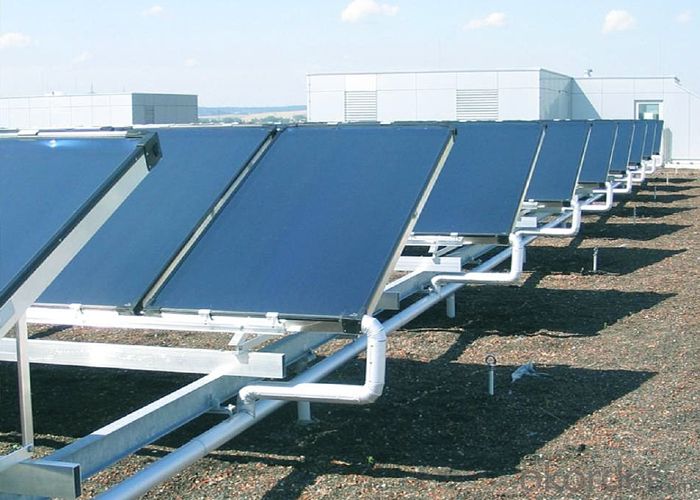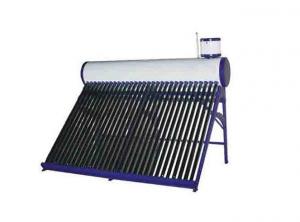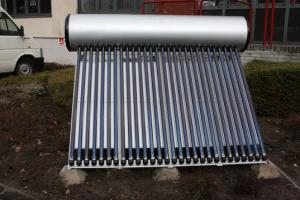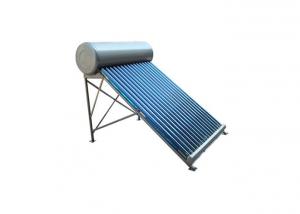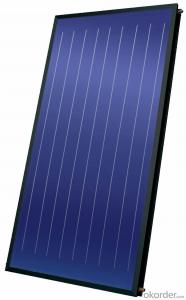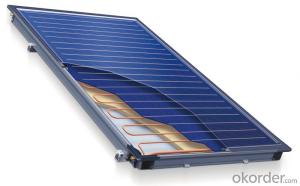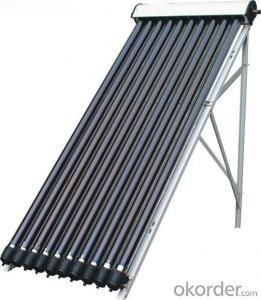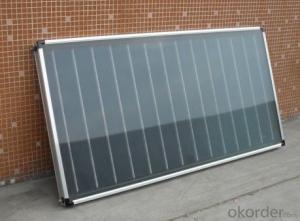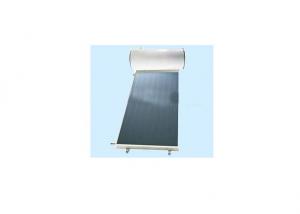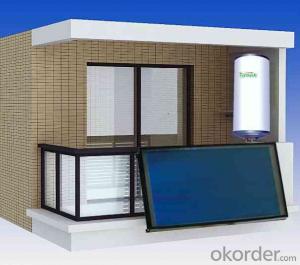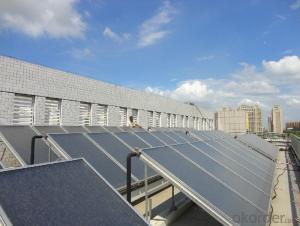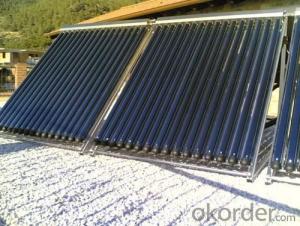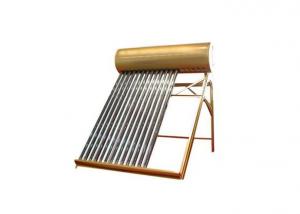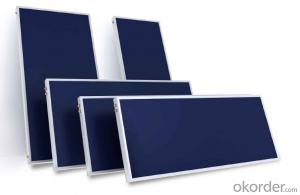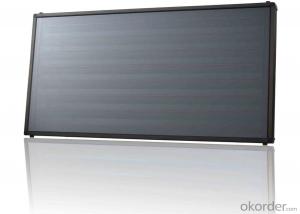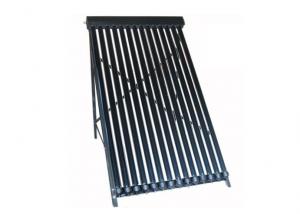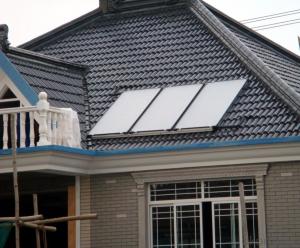Best Solar Collectors - CNBM High Efficiency Solar Thermal Collector
- Loading Port:
- Shanghai
- Payment Terms:
- TT OR LC
- Min Order Qty:
- 500 pc
- Supply Capability:
- 10000 pc/month
OKorder Service Pledge
OKorder Financial Service
You Might Also Like
Specifications
1.Warm/cold place available
2.50 tubes non pressure
3.Beautiful design
4.Best service and high quality with competive pric
HURRAS SOLAR are professional split and pressurized solar water heater, pressurized solar collector, non-pressurized solar collector for project, domestic solar water heater, solar thermal hot water Manufacture.
Direct flow Vacuum Tube Solar Collector for Project Features:
1 Use high quality evacuated tubes maximize the daily output.
2.Quality 304 stainless steel special for sea side and high air pollution area.
3.stardard food grade 304 2 B stainless steel inner tank with perfect tank design ensure the reliable quality.
4.High density import Polyurethane insulation with a perfect performance of reduce the heat lose of the water tank.
5.Big capacity
Direct flow Vacuum Tube Solar Collector for Project Technical Data :
Max. Work pressure:1.5 bar
Absorption rate > 93%
Max. wind resistance: 17m/s
Max. Hall resistance: 25mm in diameter
Work temperature: -10 C ~ 200 C
Vacuum tube solar collector applications:
1.Hotels, resorts, hospitals and hostels
2.Process industry, boiler feed, laundry and canteens
3.Agricultural sector, hatcheries and dairies
4.Process industry, Boiler feed, Laundry and canteens
5.Agricultural sector, hatcheries, and dairies
6.Swimming pool heating
7.In-process heating
8.Health clubs (Steam / Sauna)
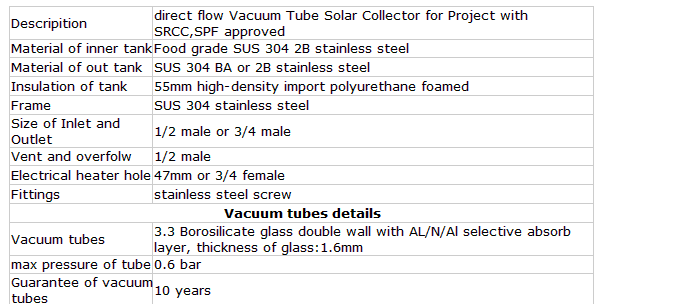
- Q: How much electricity can a solar collector generate?
- The amount of electricity that a solar collector can generate depends on various factors such as the size and efficiency of the collector, the amount of sunlight available, and the location of the collector. On average, a solar collector can generate anywhere from a few hundred watts to several kilowatts of electricity.
- Q: What is the minimum required sunlight for a solar collector to operate?
- The minimum required sunlight for a solar collector to operate effectively is typically around 1000 watts per square meter, although this can vary depending on the specific type and design of the collector.
- Q: Can solar collectors be used for generating electricity on medical devices?
- Yes, solar collectors can be used for generating electricity on medical devices. By harnessing the power of the sun, solar collectors can provide a sustainable and renewable source of energy to power various medical devices, ensuring their continuous operation even in areas with limited access to electricity.
- Q: Can solar collectors be used in pharmaceutical manufacturing?
- Solar collectors have the potential to be utilized in pharmaceutical manufacturing. These devices, also referred to as solar thermal systems, are capable of producing heat for a variety of industrial procedures, including pharmaceutical manufacturing. By harnessing the sun's energy, solar thermal systems can heat water or other fluids, which can then be applied in pharmaceutical production for tasks like sterilization, drying, and distillation. Through the implementation of solar collectors, pharmaceutical manufacturing facilities can decrease their reliance on non-renewable energy sources like fossil fuels and significantly diminish their carbon footprint. This can contribute to a more sustainable and eco-friendly production process. Additionally, solar thermal systems can assist companies in reducing their energy expenses by utilizing the abundant and free solar energy available. However, it should be noted that the use of solar collectors in pharmaceutical manufacturing may have limitations depending on the specific requirements of the manufacturing processes. Certain pharmaceutical production procedures may necessitate high temperatures or specific heating methods that may not be achievable with solar thermal systems alone. In such cases, solar collectors can be combined with other heating sources or technologies to meet the necessary requirements. In conclusion, solar collectors have the potential to play a valuable role in pharmaceutical manufacturing by providing clean and renewable heat energy, reducing environmental impact, and potentially lowering energy costs.
- Q: Can solar collectors be used in combination with other renewable energy sources?
- Yes, solar collectors can be used in combination with other renewable energy sources. This combination, known as hybrid renewable energy systems, can help increase overall energy production and improve reliability. For instance, solar collectors can be integrated with wind turbines or hydroelectric power to create a more balanced and continuous energy supply, maximizing the utilization of renewable resources. Additionally, combining solar collectors with other renewable sources allows for better energy management and storage options, enhancing the overall efficiency and sustainability of the system.
- Q: How do solar collectors affect the humidity of indoor swimming pools?
- Solar collectors have no direct impact on the humidity of indoor swimming pools. Their main function is to capture sunlight and convert it into heat energy in order to warm the pool water. This ensures a comfortable temperature for swimmers, without relying entirely on traditional energy sources. Nevertheless, it is worth noting that higher temperatures can lead to an increase in the evaporation rate of water. As solar collectors effectively heat up the pool water, they indirectly contribute to a potential rise in evaporation. Consequently, the humidity levels in the pool area may experience a slight increase. To regulate humidity levels, indoor swimming pools typically have appropriate ventilation and dehumidification systems installed. These systems work to control humidity by removing excess moisture from the air, preventing issues such as condensation, mold growth, and discomfort for swimmers. Therefore, while solar collectors themselves do not directly influence the humidity of indoor swimming pools, they can indirectly impact humidity levels by heating the pool water. This may require the use of suitable ventilation and dehumidification systems to maintain optimal conditions in the pool area.
- Q: How do solar collectors perform in areas with high levels of bird or insect activity?
- Solar collectors can be affected by high levels of bird or insect activity in certain ways. Birds and insects may occasionally perch or nest on the collectors, which can block sunlight from reaching the surface and reduce their efficiency. Additionally, bird droppings and insect debris can accumulate on the collectors, creating a film that further obstructs sunlight. This buildup can decrease the amount of energy captured by the collectors and, over time, reduce their overall performance. To mitigate these issues, there are a few measures that can be taken. One option is to install deterrents, such as spikes or netting, around the solar collectors to prevent birds from perching or nesting on them. This can help minimize the shading and debris accumulation caused by the bird activity. In the case of insects, regular cleaning and maintenance of the collectors can help remove any debris or buildup that may impede their performance. It is worth mentioning that not all bird or insect activity will have a significant impact on solar collectors. In areas with high levels of activity, it is recommended to assess the situation on a case-by-case basis and implement appropriate prevention measures accordingly. Overall, with proper maintenance and proactive steps to deter birds and insects, solar collectors can continue to perform effectively even in areas with high levels of activity.
- Q: Can solar collectors be used in conjunction with other energy sources?
- Yes, solar collectors can be used in conjunction with other energy sources. This is known as hybrid energy systems, where solar collectors are combined with other sources like wind, hydroelectric, or fossil fuels. This integration allows for a more reliable and continuous energy supply, as multiple sources can compensate for each other's variations in availability.
- Q: Can solar collectors be installed on a flat roof?
- Yes, solar collectors can be installed on a flat roof. In fact, flat roofs are a popular choice for solar installations as they provide a large surface area for optimal sun exposure and can be easily accessed for maintenance and installation purposes.
- Q: Can solar collectors be integrated into existing heating systems?
- Yes, solar collectors can be integrated into existing heating systems. By installing solar collectors, the system can harness the sun's energy to provide heat, reducing reliance on traditional heating sources and lowering energy costs. This integration can be done through retrofitting or incorporating solar thermal panels into the existing infrastructure, making it a viable option for both residential and commercial buildings.
Send your message to us
Best Solar Collectors - CNBM High Efficiency Solar Thermal Collector
- Loading Port:
- Shanghai
- Payment Terms:
- TT OR LC
- Min Order Qty:
- 500 pc
- Supply Capability:
- 10000 pc/month
OKorder Service Pledge
OKorder Financial Service
Similar products
Hot products
Hot Searches


